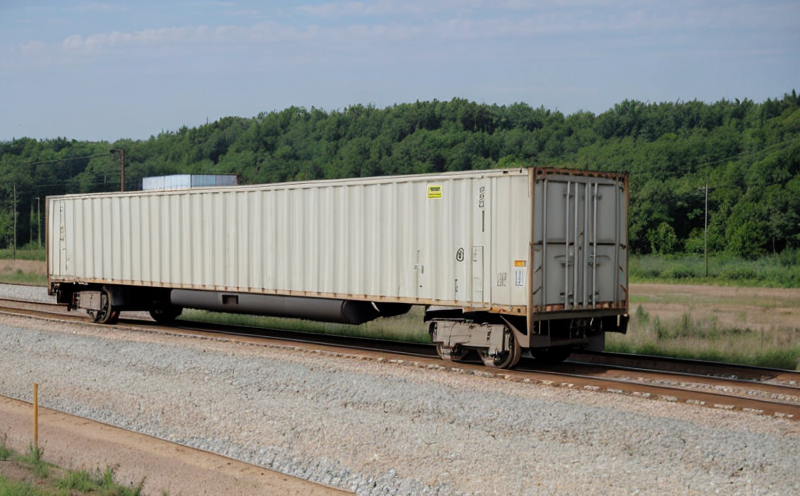EN 13260 Wheelset Strength Testing for Freight Wagons
The European Standard EN 13260 sets out the requirements and procedures for testing the strength of wheelsets used in freight wagons. This standard is crucial for ensuring that railway vehicles are safe, reliable, and capable of withstanding the rigors of long-distance transportation.
Wheelsets form a critical part of freight wagons, providing the necessary interface between the wagon body and the rail infrastructure. They must be robust enough to handle high loads and frequent wheel-rail interactions without failure. EN 13260 addresses these requirements by specifying the methods for testing the structural integrity of wheelsets under various loading conditions.
The standard applies to new and repaired wheelsets, ensuring that all components meet stringent quality standards before being incorporated into operational freight wagons. Compliance with EN 13260 is a requirement in many European countries as well as international markets where safety and reliability are paramount.
Testing according to EN 13260 involves several key steps, including the selection of appropriate test specimens, the application of specified loading conditions, and the evaluation of structural integrity. The process ensures that wheelsets can withstand the forces exerted during normal operation while also being robust enough to handle exceptional circumstances such as derailments or heavy load surges.
Before testing, it is essential to prepare the wheelset specimens according to the standard's specifications. This may involve cleaning and inspecting the components for any defects that could compromise the test results. Once prepared, the wheelsets are subjected to a series of static and dynamic loading tests designed to simulate real-world operating conditions.
The testing apparatus used in EN 13260 must be capable of applying precise loads and measuring responses accurately. The equipment typically includes hydraulic presses or similar devices that can exert controlled forces on the wheelset axles. Sensors are employed to monitor critical parameters such as stress, strain, and deformation during loading.
The acceptance criteria for EN 13260 testing are stringent, ensuring that only wheelsets capable of withstanding specified loads without failure are deemed fit for use in freight wagons. Compliance with these criteria is essential for maintaining the integrity of railway infrastructure and enhancing public safety.
Compliance officers, quality managers, R&D engineers, and procurement teams within the transportation sector rely on EN 13260 testing to ensure that their wheelsets meet international standards. By adhering to this standard, organizations can demonstrate commitment to high-quality manufacturing processes and enhance reputation in competitive markets.
The rigors of testing according to EN 13260 are designed to identify potential weaknesses in design or materials early on in the production process. This proactive approach helps prevent costly repairs and disruptions once wheelsets have been integrated into operational freight wagons. The standard's emphasis on robustness also contributes to longer service life and reduced maintenance costs over time.
Moreover, compliance with EN 13260 can provide significant competitive advantages for manufacturers operating within the railway and transportation industry. Meeting international standards enhances brand reputation and opens doors to new markets where stringent safety regulations are in place.
Scope and Methodology
| Test Parameters | Description |
|---|---|
| Static Load Testing | Application of fixed loads to simulate typical operating conditions. |
| Dynamic Load Testing | Evaluation under variable loading scenarios to assess resilience. |
| Strain Measurement | Use of sensors to monitor deformation during testing. |
| Stress Analysis | Calculation of internal forces within the wheelset components. |
The scope of EN 13260 covers both new and repaired wheelsets, ensuring consistency in quality across all stages of production. The methodology involves precise application of static and dynamic loads to evaluate structural integrity thoroughly. Sensors are used to measure strain and stress levels, providing detailed insights into the behavior of wheelset components under various loading conditions.
Industry Applications
- Railway vehicle manufacturers ensuring compliance with international standards.
- Transportation companies seeking to enhance safety and reliability in their fleet.
- R&D teams developing new designs for more efficient and robust wheelsets.
- Procurement departments sourcing high-quality materials and components.
The applications of EN 13260 extend beyond individual organizations, contributing to the broader goals of the railway industry. By ensuring that all wheelsets meet stringent quality standards, this standard plays a vital role in maintaining the integrity of rail infrastructure across Europe and beyond.
Customer Impact and Satisfaction
- Increased safety for passengers and cargo due to robust wheelset design.
- Enhanced reputation among clients and stakeholders through compliance with international standards.
- Improved operational efficiency by minimizing downtime associated with wheelset failures.
- Cost savings from reduced maintenance and replacement expenses over time.
Clients who adopt EN 13260 testing benefit from improved product quality, enhanced safety features, and greater market confidence. These positive outcomes contribute to increased customer satisfaction levels across the industry.





